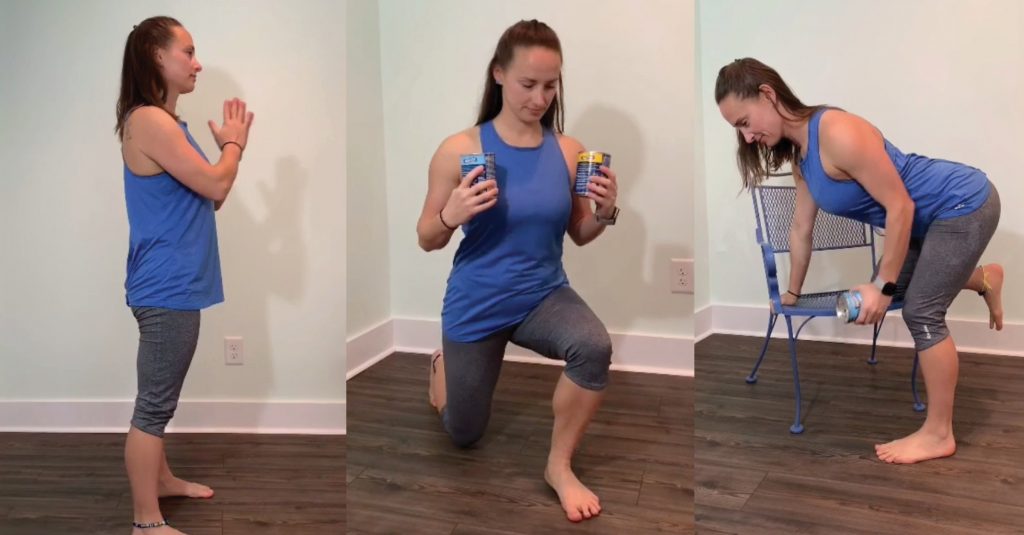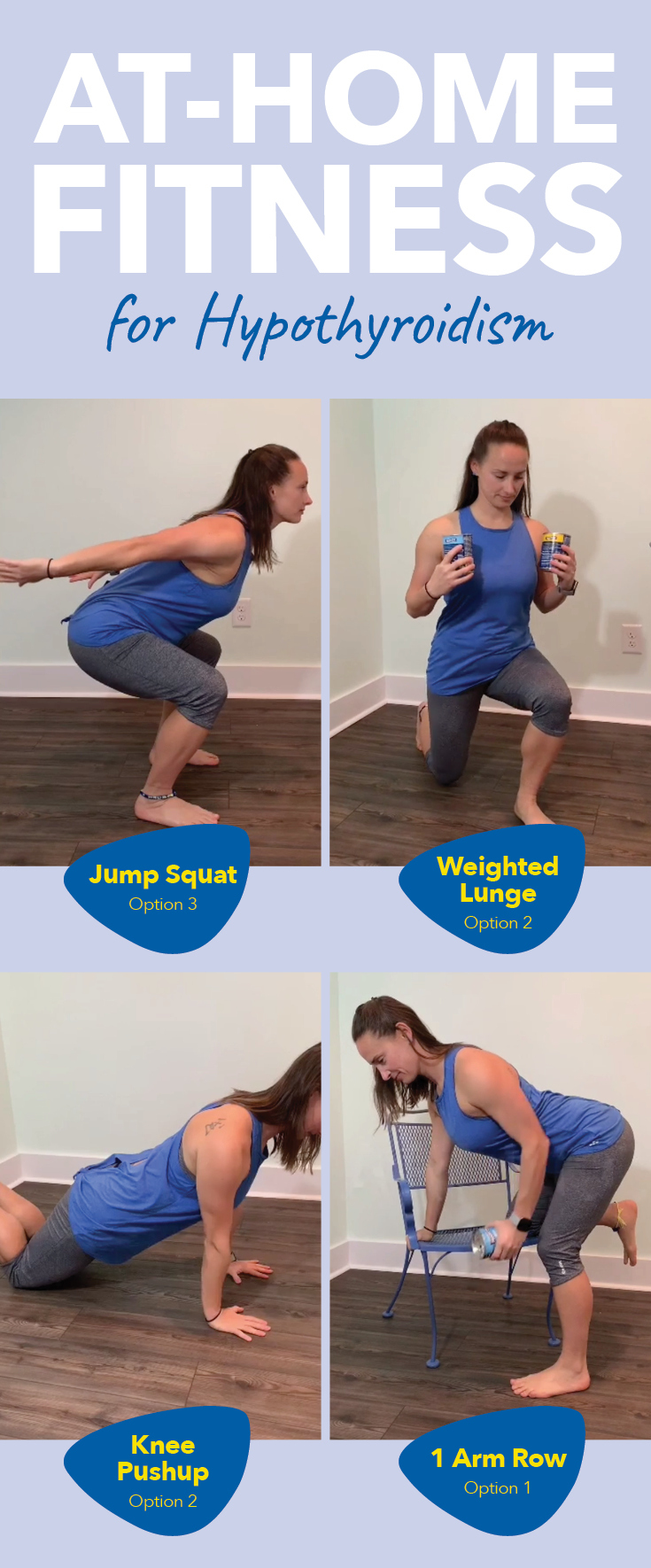Expert Advice

Acella Pharmaceuticals, LLC., is partnering with Angila Berni, B.S., SFG2 to bring greater awareness to the importance of thyroid care and education. This post is sponsored by Acella Pharmaceuticals and should not be construed as medical advice. Please talk to your doctor about your individual medical situation.
Disclaimer: The information provided is for educational purposes only and does not substitute professional medical advice. Consult a medical professional or healthcare provider before beginning any exercise, fitness, diet, or nutrition routine.
Finding the right fitness routine may help combat the symptoms associated with hypothyroidism. Here’s an overview of some workouts you can design and completed almost anywhere, including from home.
After you’ve been cleared by a doctor to exercise with no limitations, the following may be completed.
Begin each exercise routine with a five to 10-minute warmup. Start with a five-minute walk, then complete the following movements for three sets of 30 seconds each:
Warm Up
March in place, twists, toe touches, butt kick and arm, wrist, and ankle circles (both directions). Add any additional warmup exercises you enjoy.If you are new to exercising, be sure to listen to your body. If an exercise doesn’t feel right or causes pain, don’t do it! For low-intensity, complete the following exercises for 30 seconds; for moderate intensity, complete for 45 seconds; for high-intensity, complete for 60 seconds.
Strength-Endurance
Squat
Option 1.
Chair sit – Start with feet hip to shoulder-width apart. Sit down on a chair and then stand tall, squeezing the glutes and core.
Option 2.
Air squat – Start with feet shoulder-width apart. Begin by hinging at the hips and lower the body down as if sitting in a chair. Maintain an upright torso and ascend by squeezing the glutes and core. Finish standing tall.
Option 3.
Jump squat – Begin in the same way as the air squat and finish with a jump. Land softly to reduce impact.
Pushup
Option 1.
Wall pushup – Start with your hands on the wall at shoulder-width apart. Be sure to keep the body rigid while bending at the elbows to lower the body and while pushing back to the starting position.
Option 2.
Pushup on knees – Start by lying on the ground with the hands under the shoulders. Keeping the core and glutes activated, push the body away from the floor while the knees remain on the ground.
Option 3.
Pushup on toes – Curl the toes under and maintain a straight body position while pushing the body off the ground.
Lunge
Option 1.
Reverse lunge – Start by standing tall, then take a step back with one foot. Lower the back knee down to a comfortable angle and ascend back to the standing position. Hold on to a chair for balance.
Option 2.
Reverse lunge with weight – Increase the intensity by holding dumbbells, canned good or a gallon of water.
Option 3.
Split lunge – Start in a staggered stance. Lower the body slightly and push off the ground to switch the leg position during a jump. Land softly with the opposite foot forward.
Row
Option 1.
Chair row – The body maintains a modified tabletop position by placing a single knee and hand on a chair, while the other foot stays planted on the ground. The free hand holds a dumbbell, canned good or gallon of water and pulls the elbow close to the body as it ascends.
Option 2.
Bent over row – Stand tall with feet hip-width apart while holding a weight in each hand. Hinge at the hips and maintain a flat back while leaning forward at a comfortable angle. Keeping the core engaged and arms straight, begin pulling the elbows back toward the torso and squeezing the shoulder blades together.
Cardio
Complete at least one of the following. Mix it up and make it your own.
Jumping jacks
Jogging in place
Jumping rope
Climbing steps
Star jumps
Tuck jumps
Sprints
Burpees
Core
Complete at least two of the following at the end of your workout:
Plank
Side plank
V-sit
Situp
Bicycle crunch
Flutter kicks
Leg raises
Bird dog
Superman
Complete three to five sets of each exercise listed. Rest as needed in between exercises and for two to three minutes between sets. Mix and match to make it your own. Enjoy the benefits of working out at any time, in any location!

ML-0142-v2
Note that DTE products, including NP Thyroid®, have not been reviewed by the FDA for safety or efficacy.
IMPORTANT RISK INFORMATION, INCLUDING BOXED WARNING & INDICATIONS
Important Risk Information
Drugs with thyroid hormone activity, alone or together with other therapeutic agents, have been used for the treatment of obesity. In euthyroid patients, doses within the range of daily hormonal requirements are ineffective for weight reduction. Larger doses may produce serious or even life-threatening manifestations of toxicity, particularly when given in association with sympathomimetic amines such as those used for their anorectic effects.
- NP Thyroid® is contraindicated in patients with uncorrected adrenal insufficiency, untreated thyrotoxicosis, and hypersensitivity to any component of the product.
- In the elderly and in patients with cardiovascular disease, NP Thyroid® should be used with greater caution than younger patients or those without cardiovascular disease.
- Use of NP Thyroid® in patients with diabetes mellitus or adrenal cortical insufficiency may worsen the intensity of their symptoms.
- The therapy of myxedema coma requires simultaneous administration of glucocorticoids.
- Concomitant use of NP Thyroid® with oral anticoagulants alters the sensitivity of oral anticoagulants. Prothrombin time should be closely monitored in thyroid-treated patients on oral anticoagulants.
- In infants, excessive doses of NP Thyroid® may produce craniosynostosis.
- Partial loss of hair may be experienced by children in the first few months of therapy but is usually transient.
- Adverse reactions associated with NP Thyroid® therapy are primarily those of hyperthyroidism due to therapeutic overdosage.
- Many drugs and some laboratory tests may alter the therapeutic response to NP Thyroid ®. In addition, thyroid hormones and thyroid status have varied effects on the pharmacokinetics and actions of other drugs. Administer at least 4 hours before or after drugs that are known to interfere with absorption. Evaluate the need for dose adjustments when regularly administering within one hour of certain foods that may affect absorption.
- NP Thyroid® should not be discontinued during pregnancy, and hypothyroidism diagnosed during pregnancy should be promptly treated.
Indications
NP Thyroid® (thyroid tablets, USP) is a prescription medicine that is used to treat a condition called hypothyroidism from any cause, except for cases of temporary hypothyroidism, which is usually associated with an inflammation of the thyroid (thyroiditis). It is meant to replace or supplement a hormone that is usually made by your thyroid gland.
NP Thyroid® is also used in the treatment and prevention of normal functioning thyroid goiters, such as thyroid nodules, Hashimoto’s thyroiditis, multinodular goiter, and in the management of thyroid cancer.
Revised
10/2023
You Are About To Leave This Website
By clicking continue, this link will take you to a website to which Alora Pharmaceuticals’ Policies & Terms of Use do not apply.
